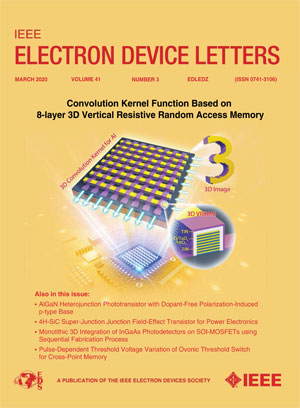Imprinted Antiferroelectric With Low Damage Process for High Performance Negative Capacitance NAND Flash Memory
IF 4.1
2区 工程技术
Q2 ENGINEERING, ELECTRICAL & ELECTRONIC
引用次数: 0
Abstract
The concept of negative capacitance (NC), originating from the intrinsic energy configuration of HZO ferroelectrics, has been predominantly utilized in logic transistors to achieve a steeper Id-Vg characteristic. Departing from these conventional approaches, we have developed an NC-NAND flash memory by integrating the NC phenomenon into the blocking oxide layer of conventional NAND flash memory. By leveraging the capacitance boosting effect of the NC-integrated blocking oxide (BO) layer, we can significantly enhance program (PGM) efficiency and lower the operating voltage of charge trap memory. In this work, we propose two combined approaches to improve the NC. First, we applied asymmetric tensile stress to the HZO layer through high-pressure annealing (HPA), thereby generating an internal electric field across the HZO layer. Additionally, we improved the polarization property of the HZO layer by employing a low-damage process during the deposition of the capping TiN electrode, minimizing interfacial damage to the HZO surface. Step-pulsed I-V measurement confirmed that the capacitance boosting effect of the NC blocking oxide with the low-damage process was improved by 16.7%, while the operating voltage was reduced by 1 V. Additionally, the NC-NAND flash memory with the low-damage process exhibited a significant higher ISPP slope characteristic.求助全文
约1分钟内获得全文
求助全文
来源期刊

IEEE Electron Device Letters
工程技术-工程:电子与电气
CiteScore
8.20
自引率
10.20%
发文量
551
审稿时长
1.4 months
期刊介绍:
IEEE Electron Device Letters publishes original and significant contributions relating to the theory, modeling, design, performance and reliability of electron and ion integrated circuit devices and interconnects, involving insulators, metals, organic materials, micro-plasmas, semiconductors, quantum-effect structures, vacuum devices, and emerging materials with applications in bioelectronics, biomedical electronics, computation, communications, displays, microelectromechanics, imaging, micro-actuators, nanoelectronics, optoelectronics, photovoltaics, power ICs and micro-sensors.
 求助内容:
求助内容: 应助结果提醒方式:
应助结果提醒方式:


